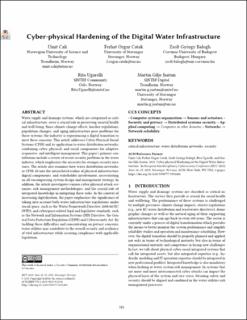| dc.description.abstract | Water supply and drainage systems, which are categorized as critical infrastructure, serve a crucial role in preserving societal health and well-being. Since climate change effects, harsher regulations, population changes, and aging infrastructure pose problems for these systems, the industry is experiencing a digital transition to meet these concerns. This article addresses Cyber-Physical-Social Systems (CPSS) and its application to water distribution networks, combining cyber, physical, and social components for adaptive, responsive, and intelligent management. This paper’s primary contributions include a review of recent security problems in the water industry, which emphasizes the necessity for stronger security measures. The article also examines how water distribution networks, as CPSS, fit into the interrelated realms of physical infrastructure, digital components, and stakeholder involvement, necessitating an all-encompassing system design and management strategy. In addition, the article investigates various cyber-physical attack scenarios, risk management methodologies, and the crucial role of integrated knowledge in mitigating these risks. In the context of increasing digitalization, the paper emphasizes the significance of taking into account both water infrastructure regulations under social space, such as the Water Framework Directive 2000/60/EC (WFD), and cyberspace-related legal and legislative standards, such as the Network and Information Systems (NIS) Directive, the General Data Protection Regulation (GDPR) and Cybersecurity Act. By tackling these difficulties and concentrating on privacy concerns, water utilities may contribute to the overall security and resiliency of vital infrastructure while assuring compliance with applicable legislation. | en_US |

